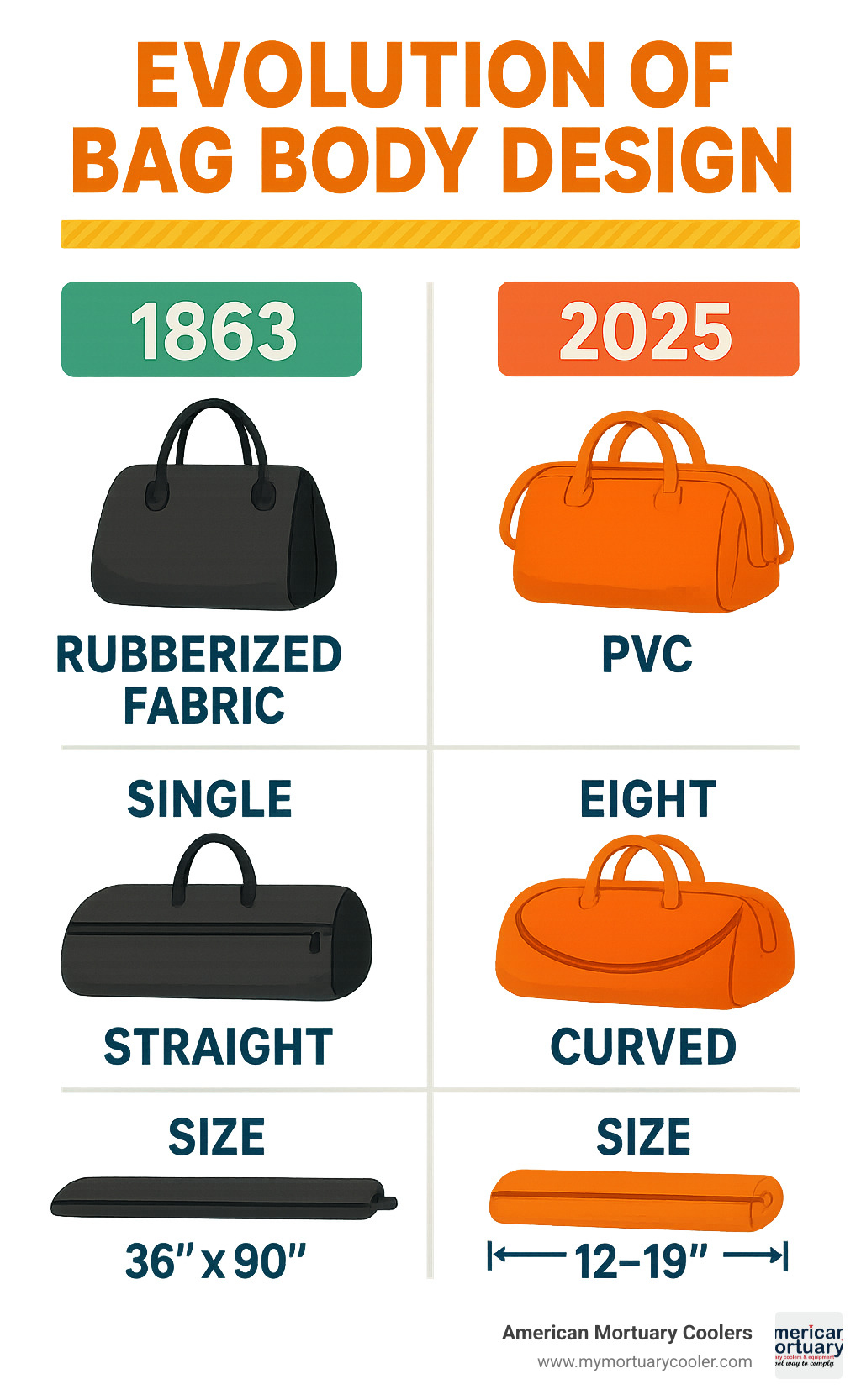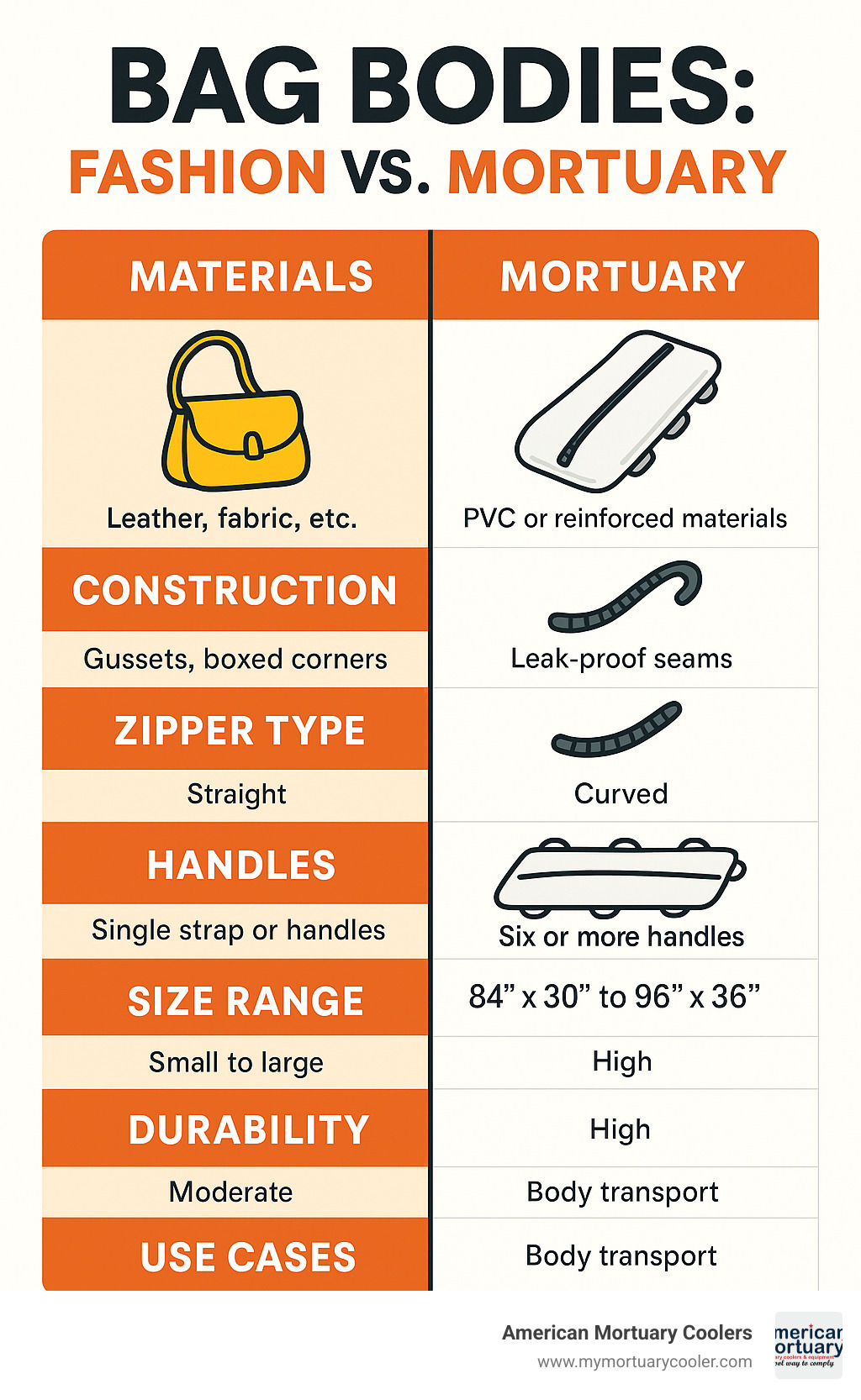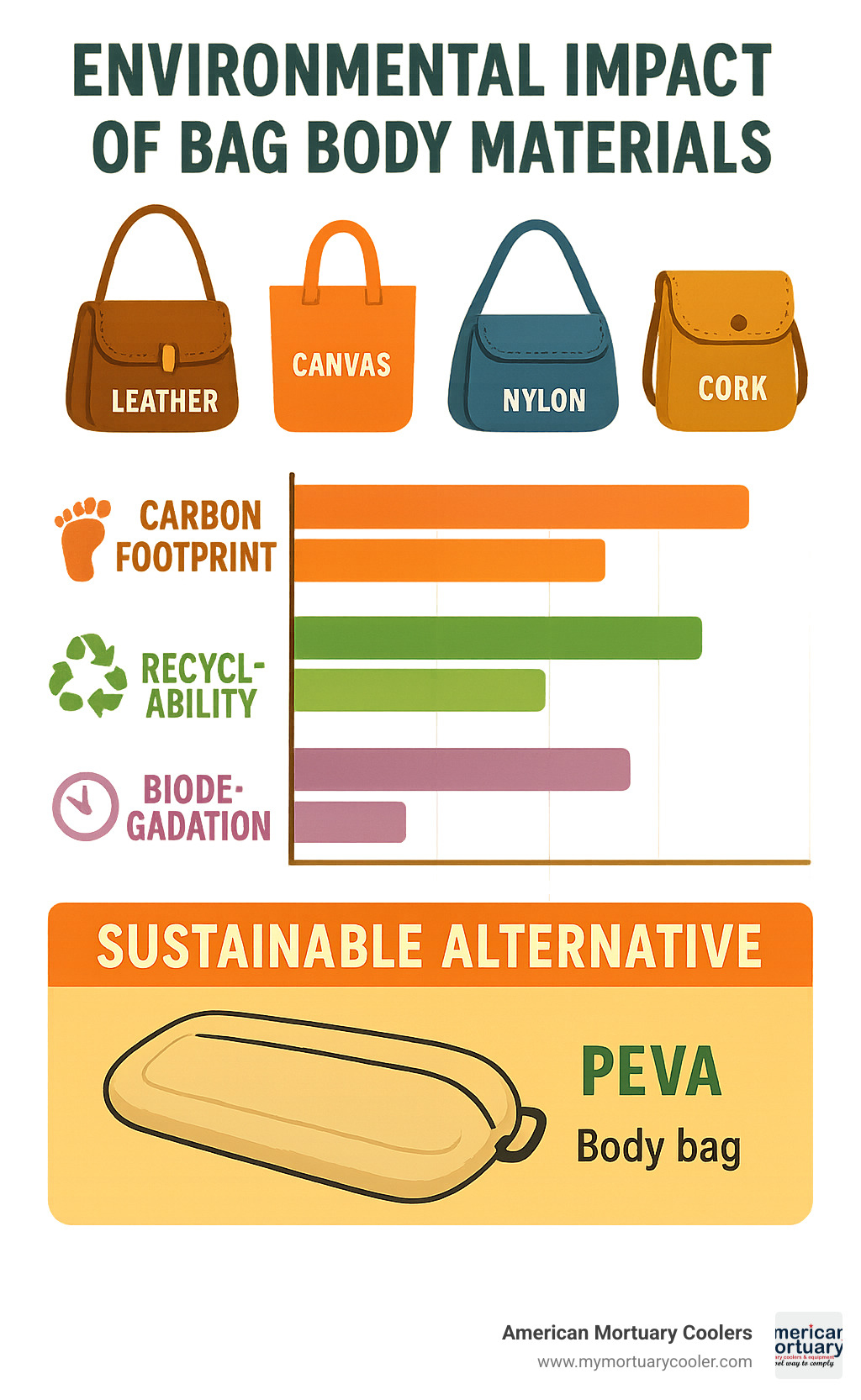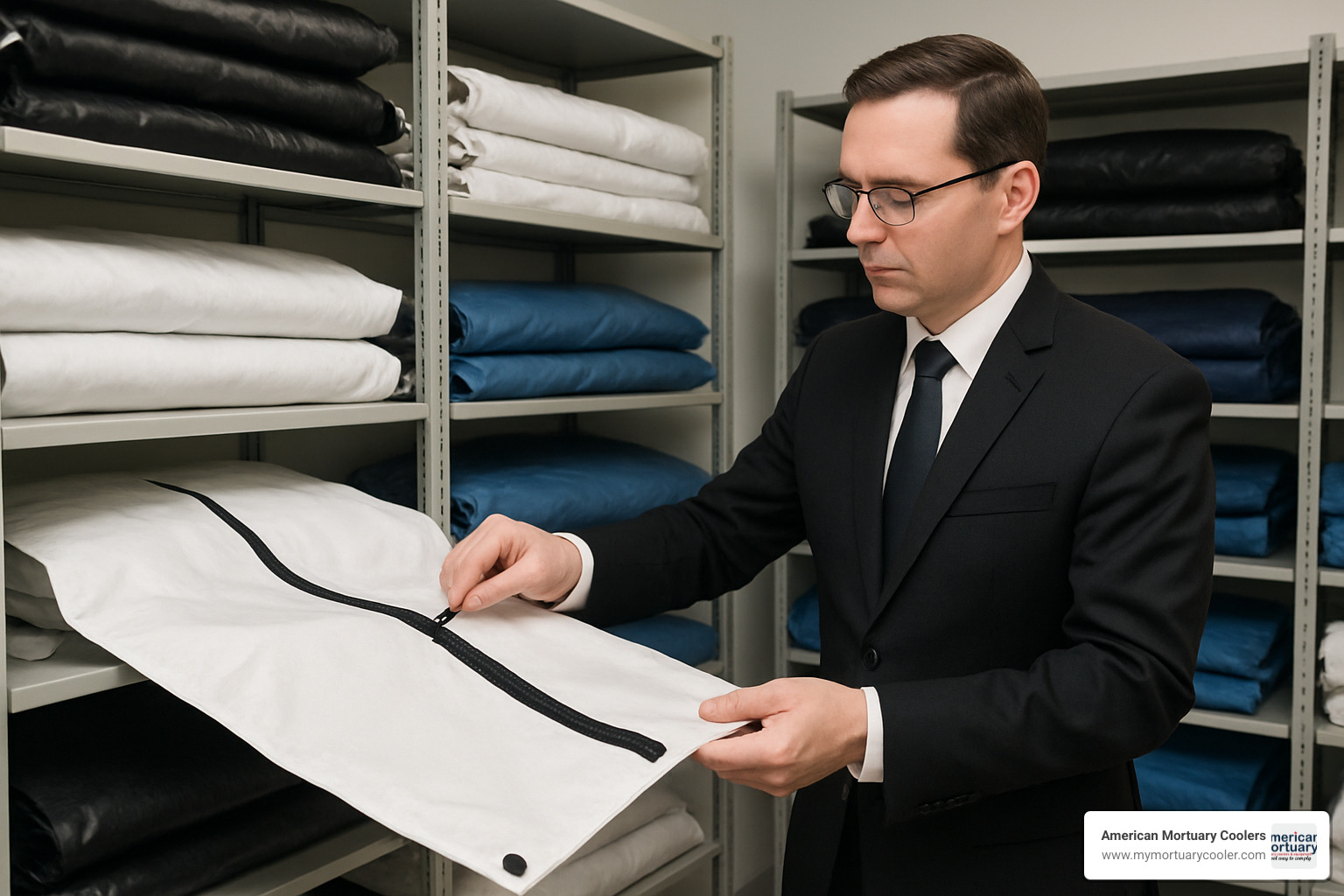Understanding Bag Body: From Fashion to Funeral Services
When someone searches for bag body, they're typically looking for one of two very different things: fashionable crossbody bags and purses, or specialized body bags used in mortuary and emergency services. Here's what you need to know:
Fashion Bag Bodies:
- Crossbody bags, bucket bags, totes, and hobos
- Materials: leather, canvas, nylon, cork
- Features: adjustable straps, multiple compartments, various closures
- Sizes: typically 12-19 inches wide
Mortuary Bag Bodies:
- Human remains pouches (HRP) or cadaver pouches
- Standard dimensions: 36" x 90" (91 cm x 229 cm)
- Materials: 6-12 mil PVC, reinforced vinyl
- Features: leak-proof seams, curved zippers, multiple handles
The term "bag body" refers to the main structure or shell of any bag - whether it's a designer handbag or a professional body bag used by funeral homes and emergency responders.
Body bags have evolved significantly since Dr. Thomas Holmes received the first patent in 1863. Originally made of heavy-duty black rubberized fabric during the Vietnam War, modern versions use white or colored PVC for better evidence detection and come in various sizes - from preemie bags to oversized disaster pouches.
For funeral directors, understanding bag body construction is crucial. The difference between 8-mil and 12-mil thickness, handle configurations (6, 8, or 12 handles), and zipper types (straight, J-shaped, or curved) can impact both functionality and cost-effectiveness in your operations.
I'm Mortuary Cooler from American Mortuary Coolers, and I've spent over a decade helping funeral homes select the right bag body solutions for their specific needs. My experience ranges from standard mortuary pouches to specialized disaster response equipment, ensuring funeral directors get reliable, American-made products that meet their operational requirements.

Bag body terms at a glance:
Bag Body Fundamentals & Evolution
When we talk about bag body, we're really talking about the heart of any bag - the main structure that holds everything together. Whether it's a trendy crossbody bag or a professional mortuary pouch, the bag body is what gives it shape and purpose.
The story of mortuary bag body design starts way back during the Civil War. Dr. Thomas Holmes was dealing with a real problem - how to transport fallen soldiers with dignity and practicality. On July 21, 1863, he filed what would become U.S. Patent No. 39,291, creating the first official body bag design. It was a game-changer for both military and civilian use.
Modern body bags stick to pretty standard dimensions - about 36 inches wide by 90 inches long. That's roughly 3 feet by 7.5 feet, which accommodates most adults comfortably. Compare that to fashion bag bodies, which can be tiny clutches or massive totes, or even carry-on luggage that has to squeeze into those strict 9×14×22 inch airline rules.
The language around these products has gotten more respectful over time. What used to be called "body bags" are now Human Remains Pouches (HRP) or cadaver pouches. It's the same functional item, but the terminology reflects how the funeral industry has evolved toward more dignified language.
Here's something interesting - during the Vietnam War, bag body construction was all about heavy-duty black rubberized fabric. But modern versions? They're mostly white or light-colored. This isn't just about looking different. White backgrounds make it much easier to spot any evidence that might fall from remains during transport. For forensic work, that's absolutely crucial.
Scientific research on body bag history shows some surprising uses beyond mortuary work. Military units in Iraq and Afghanistan got creative, using body bags as supply drops. They'd fill them with under 100 pounds of ammunition and supplies, then drop them from helicopters to troops in the field.
The evolution from 1863 to today shows how bag body design has adapted to changing needs. Early versions focused on basic containment. Modern designs consider everything from weight capacity of 400 pounds to leak-proof sealing and evidence preservation. We've gone from simple fabric pouches to engineered solutions with reinforced webbing, specialized zippers, and multiple handle configurations.
Today's sizing standards aren't just about the standard 36×90 dimensions. We now have preemie bags for the smallest cases and oversized disaster pouches for emergency response situations. Each serves a specific purpose in the modern mortuary and emergency response toolkit.
Categories & Construction: Fashion vs Utilitarian
When you're shopping for a bag body, you're entering two completely different worlds. It's like comparing a sports car to an ambulance - both have wheels and engines, but they're built for entirely different purposes.
Fashion bag bodies are all about making you look good while carrying your daily essentials. These bags need to complement your outfit, feel comfortable during long wear, and organize your life without weighing you down. The construction focuses on style, comfort, and everyday durability.
On the flip side, utilitarian bag bodies - particularly those used in mortuary and emergency services - prioritize containment, leak-proof performance, and handling extreme conditions. These aren't fashion statements; they're professional tools that must perform flawlessly when it matters most.
The construction differences are striking. Fashion bags use crossbody designs with adjustable straps for hands-free convenience, while bucket bags offer roomy interiors with drawstring closures. Tote bags maximize carrying capacity with sturdy handles, and hobo bags create those relaxed, slouchy silhouettes we love. Messenger bags blend professional appearance with smart organization.
Professional bag body construction tells a different story entirely. Standard body bags use 8-mil PVC for general mortuary work, while heavy-duty versions bump up to 12-mil reinforced materials for challenging situations. Disaster pouches come in oversized dimensions, and specialized water-recovery bags use mesh construction for aquatic operations.
The devil's in the details when it comes to construction elements. Fashion bags incorporate gussets for expansion and boxed corners for structure - think of how a well-designed purse maintains its shape even when stuffed full. Professional bags focus on leak-proof seams, reinforced stress points, and absolutely secure zipper systems.
Zipper design reveals everything about a bag body's intended purpose. Fashion bags typically use straight zippers for clean, neat lines. Mortuary bags employ curved, J-shaped, or D-shaped paths that optimize sealing while allowing easier access during loading procedures.
Handle systems reflect how each bag body gets used in the real world. Your favorite crossbody might have a single adjustable strap or convertible dual handles. Professional body bags incorporate 6-handle, 8-handle, or 12-handle webbing systems positioned specifically for safe team lifting and transport.

Bag Body Styles in Fashion
Fashion bag body design is where art meets ergonomics. Take crossbody bags - they're not just trendy, they're actually better for your posture. Instead of hanging all that weight on one shoulder, crossbody designs distribute it across your torso. Your chiropractor would approve.
The numbers tell an interesting story. Kipling alone offers over 200 styles of women's crossbody bags, with 197 models featuring water resistance and 186 including organizational pockets. That's a lot of options for something that started as a simple "hands-free" solution.
Bucket bag construction creates one of the most practical bag body shapes you can buy. The popular Bonnie Bucket Bag pattern results in a finished bag measuring 14" wide, 12" tall, and 6" deep. That oval bottom design is brilliant - it maximizes what you can fit inside while keeping the outside looking neat and structured.
Here's a fun fact: the baguette style was literally designed to carry French bread. These compact, rectangular bags became famous through "Sex and the City," but they remain perfect for minimalist carrying needs. Sometimes the most practical designs come from the most unexpected places.
The choice between structured versus slouchy bag body construction affects both how you look and how the bag performs. Structured bags require hefty interfacing and reinforcement to maintain their crisp lines, while slouchy designs accept fabric's natural drape for that effortless, casual elegance.
Body-flattering principles matter more than most people realize when choosing a bag body. Fashion experts recommend contrasting your natural silhouette - curved bags complement angular figures, while structured designs work beautifully with curvy bodies. Scale is crucial too; petite individuals should avoid oversized bags that overwhelm their frame, while taller people can confidently carry larger proportions.
Bag Body for Remains & Emergency Response
Professional bag body construction demands precision that would make a NASA engineer proud. Standard 8-mil PVC construction provides the baseline for general mortuary applications, delivering leak-proof performance up to 400 pounds weight capacity. These aren't your average bags - they feature white embossed high-density virgin PVC with heat-sealed seams on all four sides.
Oversized disaster bags represent specialized bag body engineering for when everything goes wrong. At 54" wide by 108" long, these pouches accommodate multiple casualties or unusually large remains. Their envelope-style opening and reinforced zipper systems ensure secure containment even when field conditions are less than ideal.
Handle configuration isn't just about convenience - it's about operational safety. Six-handle systems provide basic lifting capability for standard transport, while 12-handle configurations enable coordinated team lifting for heavy or awkward loads. Each handle uses reinforced webbing attachment points because failure simply isn't an option during critical operations.
The single-use policy for mortuary bag body products isn't about being wasteful - it's essential for infection control and evidence preservation. Unlike fashion bags designed for years of daily use, professional body bags are routinely discarded and incinerated after one use to prevent cross-contamination between cases.
Evidence preservation capabilities set professional bag body designs apart from consumer products. White or light-colored materials provide optimal contrast for spotting trace evidence, while secure zipper systems with locking loops prevent tampering during transport and storage. When every detail could matter in an investigation, these design choices become critical.
All About Body Bags: Understanding Their Usage provides additional technical specifications for professionals who need to select the right bag body solutions for their specific operations.
Materials, Quality & Sustainability
When you're choosing the right bag body, whether for fashion or professional use, the materials make all the difference. Think of it like buying a car - you wouldn't pick one based on color alone, right? The same logic applies to bag bodies, where material quality determines everything from how long it'll last to its environmental impact.
Let's start with fashion bag body materials, which offer some beautiful options. Leather remains the classic choice because it gets better with age, developing that gorgeous patina that makes vintage bags so sought-after. The downside? It needs regular care and isn't exactly eco-friendly. Canvas gives you that sturdy, throw-it-in-the-washing-machine convenience that busy people love. Nylon works great for travel because it's lightweight and water-resistant - perfect for those unexpected airport coffee spills. Cork is the new kid on the block, offering natural water resistance with a unique texture that's surprisingly sustainable.
Professional mortuary bag body materials tell a completely different story. Here, we're talking about serious containment and safety requirements. PVC (Polyvinyl Chloride) has been the industry workhorse for decades, available in thicknesses from 6 to 12 mil depending on your needs. PEVA (Polyethylene Vinyl Acetate) offers similar performance with less environmental impact - something more funeral homes are considering these days. High-density virgin materials ensure consistent quality without the contamination risks that come with recycled content.
The hardware quality can make or break any bag body. Fashion bags benefit from rust-resistant alloys and smooth zippers that won't snag your favorite sweater. Professional applications demand components that'll work reliably even in challenging conditions - because when you need them to work, they absolutely must work.
Seam construction varies dramatically between applications. Fashion bags might use decorative topstitching that looks great while reinforcing stress points. Mortuary bags require heat-sealed seams that create completely leak-proof barriers - there's simply no room for error here.
Weight capacity tells you everything about construction quality. A crossbody fashion bag body handles 10-15 pounds comfortably for daily use. Professional body bags must safely support up to 400 pounds, which drives everything from material thickness to handle placement and reinforcement strategies.
Environmental considerations increasingly influence bag body material choices. Over 50 years of experience as a commercial, medical, institutional, industrial, and military manufacturer and supplier has taught the industry that sustainable practices matter, even when meeting strict operational requirements.

The recycling challenge differs completely between sectors. Fashion bags often get second lives through repairs, donations, or creative repurposing. Professional body bags face strict single-use requirements due to biohazard concerns, making initial material selection and proper disposal methods crucial for environmental responsibility.
Assessing a Bag Body Before Purchase
Smart shopping means knowing what to look for before you buy. Fashion bag body assessment starts with stitch density - quality bags feature 12-15 stitches per inch with consistent tension and no loose threads. If you see uneven stitching or loose ends, keep looking.
Zipper quality reveals everything about overall construction. YKK zippers represent the gold standard for fashion applications - they're smooth, durable, and worth the extra cost. Professional bags need specialized zipper systems with locking mechanisms and materials that won't corrode over time.
Handle pull-tests might feel awkward in the store, but they're worth doing. Fashion bag handles should feel secure when you give them a firm tug - if they feel loose or wobbly, imagine what they'll be like after months of use. Professional handles must meet much higher standards with built-in safety margins.
For professional applications, leak-proof certifications provide essential quality assurance. These tests verify that the bag body maintains containment under the pressure and temperature changes encountered during transport and storage.
Your quality checklist should cover material thickness and consistency throughout the bag, seam integrity with proper reinforcement at stress points, hardware operation that feels smooth and secure, zipper alignment that closes evenly without binding, handle attachment security that inspires confidence, and overall construction symmetry that shows attention to detail.
DIY Patterns & Tutorials Featuring the Bag Body
The DIY sewing community has acceptd bag body construction as an accessible way to create custom accessories while building valuable skills. Popular patterns teach various techniques while letting you customize everything from size to style.
The Bonnie Bucket Bag pattern showcases classic bag body construction with a relaxed hobo-style silhouette. It features a recessed zipper closure and exterior double welt pocket, teaching essential techniques like interfacing application and curved seam construction. The finished bag measures 14" wide by 12" tall by 6" deep, requiring just 0.8 yards of main fabric.
The Bestie Bag pattern offers four different views, letting you customize size, strap type, and pocket configuration. This versatility teaches pattern modification skills while showing how bag body proportions affect both looks and functionality. Medium versions measure 14.5" wide by 8" tall, while large versions expand to 19.5" wide by 10" tall.
Drop-in lining techniques represent advanced bag body construction skills that create professional-looking interiors. How to finish a bag with a Drop-In style Lining — RLR Creations explains this method that produces superior results compared to fixed lining approaches.
Boxed corner methods transform flat bag body designs into three-dimensional bags. Four different techniques accommodate various skill levels: the fold method for beginners, cut-square technique for precision, gusset base for curved designs, and darted corners for soft shaping.
Essential tools make DIY bag body construction much easier. You'll want a rotary cutter and self-healing mat for accurate cutting, universal and leather needles for different materials, zipper foot and walking foot for professional results, fabric clips for vinyl and cork that pins would damage, and a Teflon presser foot for non-stick materials.
Skill level considerations help you choose appropriate projects. Beginner patterns focus on straight seams and basic construction, while advanced projects incorporate curved seams, multiple closures, and professional finishing techniques that'll make your handmade bags look store-bought.
Frequently Asked Questions about Bag Body
What is a "bag body" in both fashion and funerary contexts?
When you search for bag body, you're stepping into two completely different worlds that happen to share the same name. It's like ordering a "club sandwich" and getting either a delicious meal or membership to a golf course - context is everything!
In the fashion world, a bag body refers to the main structure of your everyday bags. Think of it as the skeleton that gives your crossbody bag its shape, or the framework that makes your tote bag sturdy enough to carry groceries. These fashion bag body designs focus on making your life easier and more stylish, with features like adjustable straps, cute pockets, and hardware that actually works when you need it.
The funeral industry uses bag body to describe something entirely different - human remains pouches, also called HRP or cadaver pouches. These aren't fashion accessories; they're professional tools that help funeral directors and emergency responders handle their important work with dignity and safety.
Both types share some basic principles: they need to be well-made, use the right materials for their job, and close securely. But that's where the similarities end. Your designer handbag needs to look good and last for years, while a professional bag body needs to contain biological materials safely and gets used only once.
How do materials influence the lifespan of a bag body?
The materials in your bag body determine whether it'll be your faithful companion for decades or something you'll replace next season. It's like choosing between a sturdy oak table and a cardboard one - they might look similar at first glance, but time tells the real story.
Professional mortuary bag body products use heavy-duty PVC materials that can handle up to 400 pounds safely. But here's the thing - they're designed to be used exactly once. These bags get disposed of after each use for safety reasons, so their "lifespan" is measured in hours, not years. The 8-mil or 12-mil PVC construction ensures they won't fail during that critical single use.
Fashion bag body materials tell a different story entirely. A quality leather bag can literally outlast its owner with proper care, developing that beautiful patina that makes vintage bags so desirable. Canvas bags offer excellent durability for everyday trips, while nylon keeps things lightweight for travel without sacrificing strength.
The weight your bag body needs to handle makes a huge difference in material choice. Your crossbody bag might carry 15 pounds of daily essentials comfortably, but a professional body bag must support 400 pounds without any risk of failure. This massive difference drives everything from material thickness to how handles are attached.
Maintenance requirements vary dramatically too. Your leather bag body needs occasional conditioning to stay supple, while canvas bags just need a gentle wash now and then. Professional bags? They require zero maintenance because they're heading to medical waste disposal after one use.
Can consumers reuse or recycle a mortuary bag body?
This is where we need to be completely clear: never attempt to reuse a mortuary bag body. It's not just a suggestion - it's a critical safety rule that protects everyone involved.
Professional bag body products follow strict single-use guidelines for excellent reasons. These bags may contain biological hazards, trace evidence, or other contamination that poses serious health risks. Even if a bag looks clean, it could harbor dangerous pathogens or interfere with ongoing investigations.
The funeral industry takes this seriously because we understand the stakes. Disaster Pouch vs Body Bags Explained covers how different designs try to balance environmental concerns with these non-negotiable safety requirements.
We're not ignoring environmental concerns, though. The industry is developing eco-friendlier alternatives like PEVA materials that perform just as well as traditional PVC but break down more safely. Some facilities are exploring water-soluble bags for specific applications, though these work only for short-term use.
Proper disposal follows established medical waste protocols. Most funeral homes incinerate used bag body products in controlled systems that destroy any potential contaminants while managing emissions responsibly. It's not perfect, but it's the safest approach we have right now.
If you're a consumer who somehow encountered a professional bag body product, please don't try to repurpose it. These products aren't designed for consumer use and may not meet safety standards for everyday applications. Stick to fashion bags for your daily needs - they're designed to be reused and enjoyed for years to come.
Conclusion
After exploring the fascinating world of bag body construction - from stylish crossbody bags to professional mortuary equipment - it's clear that understanding these products helps everyone make better choices. Whether you're picking out your next favorite handbag or selecting critical equipment for your funeral home, the same principles apply: quality materials, solid construction, and reliable performance matter.
Here at American Mortuary Coolers, we've been helping funeral professionals across Tennessee, Georgia, Illinois, South Carolina, Texas, California, New York, and Pennsylvania find the perfect bag body solutions for over a decade. Our team understands that every funeral home has unique needs, and we're committed to matching you with products that maintain the dignity and professionalism your families deserve.
Choosing the right bag body isn't just about checking boxes on a spec sheet. For fashion applications, it's about finding that perfect balance between personal style, comfort, and how the bag works with your daily routine. For professional mortuary applications, it's about regulatory compliance, safety certifications, and knowing your equipment will perform reliably when families are counting on you.
Sustainability has become increasingly important in both worlds. While professional mortuary bags must remain single-use for safety reasons, we can still make environmentally conscious choices through better materials and responsible disposal methods. Fashion bags offer more opportunities for extended use, repairs, and creative repurposing when their primary life ends.
The key takeaways for smart bag body selection include understanding how material properties determine durability, recognizing that construction quality affects safety and longevity, ensuring proper sizing for optimal functionality, considering environmental impact in your decisions, and seeking professional guidance for complex requirements.
Our sustainability pledge extends beyond just selling products. We work with funeral homes to implement best practices that balance operational needs with environmental responsibility. It's about doing right by both the families we serve and the world we share.
The Complete Guide to Heavy Duty Body Bags: Find & Compare Options provides additional technical specifications and selection criteria for funeral professionals seeking optimal bag body solutions.

Ready to find the right bag body solutions for your funeral home? Contact American Mortuary Coolers today for expert guidance. Our team combines decades of industry experience with genuine care for helping you serve families with excellence. Whether you need standard mortuary pouches, specialized disaster response equipment, or custom solutions for unique situations, we're here to help you steer the bag body world with confidence.
We understand that behind every product decision is a commitment to treating families with dignity during their most difficult moments. That's why we take our role in supporting your work so seriously.
















